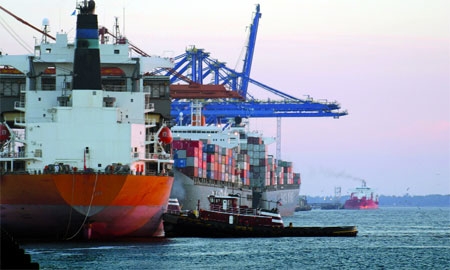Ports and port infrastructure are very important to any country with a coastline. The
Maritime and Port Institute of Angola, or
IMPA, is the body that oversees the country’s ports and its mission is to make sure goods can flow in and out of Angola as quickly and with as little difficulty as possible.
“IMPA is an institution under the authority of the Ministry of Transport and as such is the public institution that rules, controls and inspects all naval activities in the country such as: the ports, the cargo equipment, all correlated equipment and all activities related to naval and ports activities under IMPA’s administration,” explains Victor de Carvalho, IMPA’s CEO.
IMPA controls Angola’s main ports, at Luanda (which handles about 80% of the country’s imports of goods), Cabinda, Soyo, Porto Amboim, Lobito and Namibe, and is working in many ways to improve them, their physical infrastructure, their capacity and the services they provide to shippers and other users.
In one high-profile example, IMPA and the Port of Luanda worked together with the port’s other stakeholders to solve a problem that had been hurting the economy. They worked together to alleviate government red tape during the importation process that had been slowing the arrival of materials needed for the country’s immense reconstruction.
At times there was enough congestion at the port to push the number of vessels waiting to enter and offload to as high as 80. After a thorough investigation, it was found that one of the problems was that many operators in the port weren’t complying with the normal procedures. Corrective measures were taken at many different levels, and the congestion has been eliminated.
“We made everyone see that the efficient flow of the port would benefit the entire country, while the contrary would only benefit a handful of exploiters,” says Mr. de Carvalho. “Everyone was held responsible for a specific area and at last we took some practical and administrative measures and began working in accordance with those.”
‘THE GOVERNMENT AND THE MINISTRY ARE OPEN TO PUBLIC-PRIVATE PARTNERSHIPS NO MATTER WHERE THEY COME FROM’
|
More terminals and facilities were built at the port, including a dry terminal. Shippers were forced to comply with the terms in their contracts regarding parking, docking points, workers’ security and other issues. Objectives were set and all were strongly encouraged to meet them. Some traffic was also re-routed to the port of Lobito, to the south of Luanda.
IMPA and the government are working in many other ways to improve Angola’s ports. The main goals are to increase competition at every level, modernize existing ports, build new ports and revitalize the country’s maritime transport sector.
The construction, or reconstruction, of the ports is a priority. All the existing ports are being improved in many ways. The port of Cabinda is going to eventually get a new deep-water port, and temporary infrastructure will be built there to help improve the current conditions.
The facilities at Lobito have already been expanded and transformed, with a new terminal for ore transportation, a dry port and a pier to facilitate offloading operations. The project should be completed by the end of the year, for a total investment of more than $1 billion.
The ports of Namibe and Soyo are also gaining much-needed new infrastructure, with the help of credit lines from China and from Japan. A new ore-handling terminal is being considered for Namibe, and Soyo already had a new administrative facility and will eventually have a bigger and better operational area.
“The government and the ministry are open to public-private partnerships no matter where they come from; the only condition is that investors have to respect the Angolan Act governing the sector,” says Mr. de Carvalho. “Every partnership must follow the proper protocols and procedures.”
IMPA of course has many other improvement programs, for example extensive training for port staff to ensure efficiency and transparency in their operations.
The over-arching goal is to provide Angola and its trading partners with the best possible ports to help develop the economy, export the country’s mineral wealth and import needed goods.

0 COMMENTS